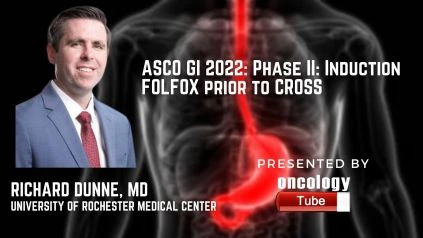Richard Francis Dunne, MD, Assistant Professor – Department of Medicine, Hematology/Oncology (SMD) at the University of Rochester Medical Center. In this interview, he speaks about the ASCO GI 2022 Abstract Induction FOLFOX prior to CROSS chemoradiotherapy and surgery in patients with locally-advanced esophageal and gastroesophageal junction cancer: A phase II study.
Origins:
In the CROSS study, it was discovered that neoadjuvant chemoradiotherapy (CRT) is given before surgery to patients with esophageal (E) and gastroesophageal junction (GEJ) malignancies improved survival. However, 10-year data did not suggest that minimizing isolated distant metastases was beneficial. Prior to CRT, adding full-dose induction chemotherapy (CT) could give early systemic disease control as well as improved local control. In patients with E/GEJ malignancies, we looked at induction CT with FOLFOX, followed by CRT and surgery.
Methodologies:
Trimodality therapy was studied in clinically staged II/III resectable tumors of the E/GEJ in this single-arm, phase II clinical research (NCT03110926). The treatment plan included 6 weeks of mFOLFOX-6 (5-fluorouracil, leucovorin, and oxaliplatin), followed by 5.5 weeks of CRT with weekly paclitaxel and carboplatin, as well as 41.4-45 Gy of RT and surgery. The Kaplan-Meier method was used to calculate 2-year relapse-free survival (RFS) from the time of surgery to the date of first recurrence or death. The primary outcomes were overall survival (OS) and major pathologic findings.
Outcomes:
In total, 41 patients with an average age of 63.1 years were enrolled, with 78 percent of them being male. Adenocarcinoma was found in almost every case (95 percent). The average length of follow-up was 2.08 years. The GE junction was home to the majority of initial malignancies (68.3 percent ). 95 percent of patients completed all FOLFOX cycles, 98 percent received the pre-specified RT dose, and 36 of 41 patients (87.7%) went on to have surgery (1 elected observation after complete clinical response). R0 resection was found in 97 percent of patients who had surgery. 30 of 36 patients (83.3%) had at least a partial pathologic response; 8 of 36 patients (22 percent, CI 10.1-39.2%) had a pathologic complete response (pCR), and 20 of 36 patients (55 percent) had a pCR or near-full response (NCR). The 2-year RFS was 71.5 percent (CI 52.1-84.2) and the median RFS was 3.1 years at the time of analysis; the median OS was not met. 85 percent (17 of 20) of those with NCR and PCR had not relapsed at the time of follow-up.
Findings:
When FOLFOX was given before CRT and surgery for E/GEJ malignancies, our study found a good treatment completion rate. R0 resection was almost universal, and more than half of the patients had NCR or pCR responses. In a cohort of virtually entirely adenocarcinoma tumors, short-term follow-up RFS and OS show encouraging efficacy for this method. In larger research, strategies for using induction FOLFOX or FLOT with or without CRT should be investigated further. NCT03110926 is the number for the clinical trial.

